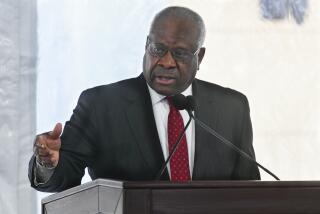Harold Greene; Presided Over AT&T; Antitrust Case
- Share via
WASHINGTON — Harold H. Greene, the much-admired federal judge who came to this country as a refugee from Nazi Germany and presided over one of the most far-reaching cases in American history--the antitrust suit that broke up American Telephone & Telegraph Co.--died Saturday at his home in Washington. He was 76.
Greene, who had retired from the bench, died of a cerebral hemorrhage.
A compassionate, unassuming man, Greene supervised a complex case that challenged the existence of a vast business empire that seemed a pillar of the American way of life. The case aroused strong passions, drew widespread attention and paved the way for the current communications revolution.
With his rulings and opinions, he became one of the best-known federal judges of his time and enhanced a reputation developed over long years for fairness, energy, intelligence and, in particular, commitment to due process, the rule of law and the independence of the judiciary.
Before gaining national prominence for approving and presiding over the consent decree that created the Baby Bells, Greene had already established a brilliant legal reputation.
He was known as a former Justice Department lawyer and official who played an integral role in creating some of the civil rights legislation that helped transform the nation in the 1960s. As a key aide and “answer man” to then-Atty. Gen. Robert F. Kennedy, he was regarded as a principal legal architect of the Civil Rights Act of 1964 and the Voting Rights Act of 1965.
Greene was born in Germany, where his father owned a jewelry store. In 1939, faced by the virulence of anti-Semitism, the family fled, making its way to Belgium, Vichy France, Spain and Portugal before arriving in this country in 1943, during World War II.
Greene, who already spoke fluent English, entered the Army and was sent back to Europe. He was in military intelligence, assigned to interrogate German prisoners.
His parents had moved from New York to Washington, and at war’s end, Greene joined them. As a veteran, he gained admission to law school after two years of college, and he began attending George Washington University law school at night.
After graduation, he began clerking in the U.S. Court of Appeals for the District of Columbia Circuit, which, because of the cases it hears, is often regarded as the second most powerful court in the nation, after the U.S. Supreme Court.
Greene was nominated by President Jimmy Carter to the U.S. District Court, where one of the first group of cases assigned to him was the AT & T matter.
“I didn’t dream up the breakup of AT & T,” Greene said.
That, he said, followed from the consent degree agreed to by the two parties to the action, AT & T and the Justice Department.
The case involved as many as 30 or 40 lawyers on either side, providing a vast engine for creating arguments and submitting motions. Trial under Greene consumed 11 months.
And indeed, Greene suggested that the “voluminous opinions” he wrote on matters arising during trial “may have had some impact” in bringing the parties to settle. Some lawyers, he said, believed that those opinions signaled what his ruling might be. But he said that was a misconception.
“I didn’t know how it was going to come out,” he said, explaining that he was “much too busy” coping with problems that arose during trial. And, he said, he never did decide the case on its merits.
The Department of Justice view was that AT & T used profits from its monopoly on local telephone service to suppress competition in the emerging long-distance and telephone equipment industries. But in the view of most of its customers, AT & T was a model provider of efficient, dependable service. They wished it had been left alone.
Greene held the view that the case “came out better than I expected,” providing “great benefit to American businesses, to the economy and to American life in general, because it brought competition to the telecommunications industry.”
Survivors include his wife of 51 years, Evelyn, of Washington; a son, a daughter and three grandchildren.
More to Read
Get the L.A. Times Politics newsletter
Deeply reported insights into legislation, politics and policy from Sacramento, Washington and beyond. In your inbox twice per week.
You may occasionally receive promotional content from the Los Angeles Times.










